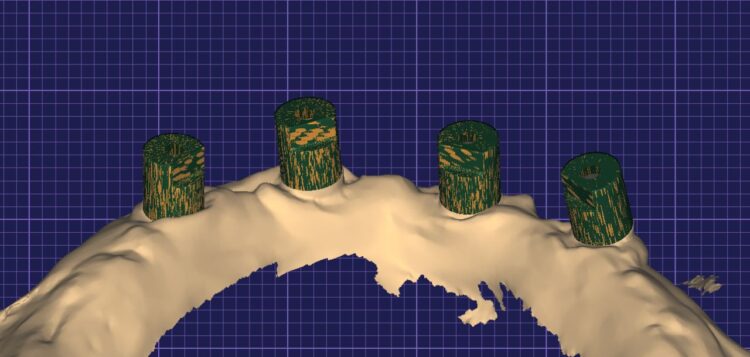
Welcoming Axiom, Roots, and Premier to the ALS Dental Group!
We’re thrilled to welcome three fantastic dental laboratories to the ALS Dental Group, further strengthening our growing dental network across the UK.
By: Victoria Macpherson
Published: 30th September 2024
Dental implants have revolutionized restorative dentistry, providing a durable and aesthetic solution for missing teeth. However, the success of dental implants depends heavily on the precision of the procedure.
Traditionally, implant surgery has been performed using a freehand or non-guided approach, relying on the skill and experience of the dentist to place the implant. While many successful outcomes have been achieved this way, the emergence of guided implant surgery has set a new standard in precision and patient outcomes.
Here’s why guided implant surgery is often considered superior to the non-guided approach.
1.Enhanced Precision and Accuracy
Guided Implant Surgery uses 3D imaging (such as Tupel 3D Photogrammetry and CBCT scans) together with planning software and a printed surgical guide. This provides the dentist with a virtual map of where to place the implants, which ensures that implants are placed at the exact location, angle, and depth as planned. This level of accuracy is almost impossible to match freehand.

In contrast, non-guided implant surgery depends largely on the dentist’s visual and tactile judgment during the procedure and relies heavily on the dentist’s clinical experience. Even experienced dentists can encounter variability, especially in complex cases. Guided surgery significantly reduces the margin of error, leading to more consistent and predictable results.
2. Improved Safety and Reduced Risk
One of the major risks in implant surgery is damage to surrounding anatomical structures, such as nerves, blood vessels, and sinus cavities. Guided implant surgery minimizes these risks by providing a clear visualization of these structures during the planning stage. The surgical guide ensures that the implants are placed in the safest possible position, avoiding critical areas.
In non-guided surgery, the risk of complications is higher, particularly in cases where the anatomy is complex, or the visibility is limited. Even slight deviations from the optimal implant position can lead to complications like nerve damage, sinus perforation, or implant failure.
3. Greater Predictability of Outcomes
Guided implant surgery allows for meticulous planning, which translates into greater predictability of outcomes. The dentist can simulate the entire procedure virtually before it is performed, considering factors such as bone density, prosthetic alignment (reduced angled screw channels), and the overall aesthetics of the final restoration. This level of preoperative planning is particularly beneficial in cases involving multiple implants or full-arch restorations. The predictability allows your Dental Laboratory to manufacture a longer lasting, better functioning, and more aesthetically pleasing final Implant Crowns that you would be able to see before carrying out the procedure.
With non-guided surgery, while many cases are successful, the lack of a surgical guide can result in unexpected challenges during the procedure, such as discovering insufficient bone volume or encountering difficulties in achieving the desired angulation.
4. Reduced Surgery Time and Improved Patient Comfort
Because guided implant surgery is pre-planned and the surgical guide dictates the exact positioning of the implant, the actual surgery is typically faster and more efficient. This is because there is usually no need to flap open the gums to visualise the bone and less need for stiches, as a result the patient typically has less swelling, less discomfort, minimises the time under anaesthesia and quicker recovery time. This also means less surgery time for dentists, resulting in less cost for the practice.
Non-guided surgery, on the other hand, may take longer due to the need for intraoperative adjustments and decision-making. The longer the procedure, the greater the chance for patient discomfort, potential complications and cost.
5. Higher Success Rates
The precision and careful planning inherent in guided implant surgery contribute to higher success rates. Proper implant positioning is crucial for osseointegration—the process by which the implant fuses with the bone. Misaligned or improperly placed implants are more likely to fail, leading to the need for additional surgeries, prolonged treatment, more cost to the dentist, and most importantly more discomfort to the patient.
Numerous studies have shown that guided implant surgery results in higher success rates compared to non-guided approaches, particularly in complex cases. This is largely due to the ability to plan and execute the surgery with a high degree of accuracy.
6. Improved Aesthetic Outcomes
The final appearance of a dental implant restoration depends significantly on the precise placement of the implant. Guided implant surgery allows for optimal placement, ensuring that the implant aligns perfectly with the surrounding teeth and tissues. This results in a more natural and aesthetically pleasing outcome, and often lower laboratory costs for the final restoration.
In non-guided surgery, achieving the ideal implant position can be more challenging, which may lead to compromises in the final appearance, such as misaligned crowns or visible metal components.
Conclusion
While non-guided implant surgery can and often does result in successful outcomes, the advantages of guided implant surgery make it the preferred choice in many cases. The use of advanced technology and meticulous planning provides enhanced precision, safety, and predictability, leading to better overall patient outcomes. For patients and dentists alike, guided implant surgery represents the future of implant dentistry, offering a more efficient, effective, and reliable approach to restoring smiles.
ALS Dental’s Veus Laboratory produces our own Implant Guide called Surgistent –

To find out more about this or how we can help support your journey for Implant guided surgery, please get in touch via email: info@veusdentallabs.co.uk

We’re thrilled to welcome three fantastic dental laboratories to the ALS Dental Group, further strengthening our growing dental network across the UK.

Zirconia Crowns and Bridges offer several advantages over Porcelain Bonded restorations. In this article Victoria Macpherson, ALS Academy Director, describes some of the key benefits.
